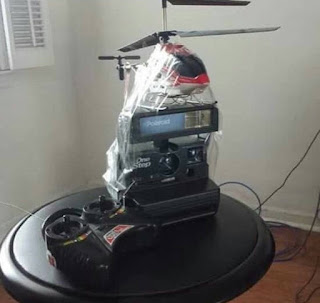It's important to determine exactly what your needs will be in terms of purchasing a UAV. Again it comes back to the mantra of "State your goal". So here is mine:
Provide customers with a service that includes the ability to capture aerial footage.
Simple. Many UAV enthusiasts prefer to build their own UAV and in doing so they have a deep knowledge of how the UAV works. The theory being that since you built it, you can fix it in the field. I have neither the desire nor inclination to do this. I will be buying what is known as an RTF UAV or Ready To Fly UAV.
We own a number of different cameras but we are disinclined to use them in conjunction with a UAV for a number of reasons:
- The weight of these cameras requires the use of a large (expensive) hexacopter.
- In the event of a crash, I will be replacing an expensive camera and repairing an expensive UAV.
- The quality of the image produced by these cameras far exceeds the needs for web publishing.
Now, while there are a number of UAVs on the market that require a minimum of pilot skills and automate much of the flying for you, most forums out there highly recommend buying a small toy UAV first and use it to learn to fly with.
- The toy will be much harder to fly than the RTF UAV and will give you actual flying skills.
- The toy can crash and survive.
- The toy is a very low risk UAV (if you fly it into your head you won't be going to the hospital).
- If you destroy it, it's so cheap you just buy another one.
OK, step one is to buy a cheap toy UAV and practice with it. But, new toy lust also makes me want to define my ultimate purchase for this. Since the UAV we will purchase is only for filming, we want one with a good camera that we can control the settings for as well as a good UAV that is well supported.
So, for more specific criteria:
- Good camera with excellent gimbal - 4K would be nice.
- Camera must have minimal barrel distortion (the super wide angle curvy looking image)
- Reliable
- Ability to control ISO, aperture and frame rate.
- Ability to have unobstructed 360 degree view with the camera (requires landing gear retraction).
- Ability to have 2 operators: Pilot and camera operator.
- Ability to automate certain flight tasks (return to home, waypoint navigation etc.).
- Ability to endure moderately windy conditions.
OK, we have criteria for the UAV, let's look at costs and how long it will take to pay for itself.
Before we look at any specific UAV, let's consider the financial implications of the purchase as a fixed asset for the business.
ROI or return on investment is something that is very important to consider whenever you purchase a tool or asset to support your business. Obviously you want a tool that represents a positive cash flow to the business, pays for itself in a timely fashion. Let's consider the following assumptions:
Aerial footage for a commercial or business profile represents a portion of the total video shot, not the entire video (generally). As such, a lower fee will be collected for aerial since that represents just a portion of the full video. For an ROI calculation I will put this number at $800.
Pure aerial videos. These will be aerial tours of facilities such as gold courses, resorts or what have you where the final video is aerial in it's entirety.
Hybrid aerial / ground video that includes other services such as motion graphics, music, editing and possible voice over. For an ROI calculation I will put this number at $3800.
The $3800 is based on our existing base package fee of $3000. Add in aerial for $800.
After subtracting my labor and overhead costs, the UAV should net about $300 per gig. We currently book about 3-5 gigs per month. If I set a budget of say $5500 for the UAV (that includes the UAV, extra batteries, case and accessories),
So we take the low end of the calculation for a worst case scenario. If we do 3 gigs per month with aerial, that's $900 / Mo. The UAV will pay for itself in approximately 10 months. That's perfectly acceptable for my business model.
So, $5500 for the UAV in total costs, we can put together the following package that meets the majority of our criteria:
DJI Inspire 1 with dual controllers: $3399+254.92 local sales tax (purchasing from local dealer).
4 DJI TB48B batteries: $793.96+59.55 sales tax
Pelican style custom case: $469 - online, no tax
4 128GB micro SD cards: $320
That puts us right around $5296.43.
Add in insurance and we are right around the target of $5500.
This UAV comes closest to meeting all of our criteria and fits within our budget. It's not perfect but closer than any of the others come. Our concerns with it are these:
You cannot get parts
Service turnaround time from DJI averages 7 weeks.
If you crash, game over for at LEAST 7 weeks.
Insurance is a must (you can check out insurance that we found in Utah here):
http://dronesetc.com/pages/accidental-damage-insurance
In part 2 of "Choosing the right UAV" we will talk about learning to fly as well as using a smaller camera UAV for training and as a possible backup UAV.

No comments:
Post a Comment